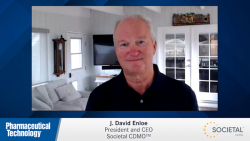
OR WAIT null SECS
- About Us
- Advertise
- Contact Us
- Editorial Info
- Editorial Advisory Board
- Do Not Sell My Personal Information
- Privacy Policy
- Terms and Conditions
© 2025 MJH Life Sciences™ , Pharmaceutical Technology - Pharma News and Development Insights. All rights reserved.
ISPE Annual Meeting Seeks to Foster Global Change
At the inaugural joint FDA/ISPE conference on CGMP earlier this year, the FDA’s Dr. Janet Woodcock delivered a strong message to the pharmaceutical industry: the efforts to adopt Quality by Design (QbD) principles within pharmaceutical manufacturing must be a top priority for the industry.
At the inaugural joint FDA/ISPE conference on CGMP earlier this year, the FDA’s Dr. Janet Woodcock delivered a strong message to the pharmaceutical industry: the efforts to adopt Quality by Design (QbD) principles within pharmaceutical manufacturing must be a top priority for the industry. She put the onus on industry and regulators to find ways to work together more effectively, to engage in productive conversations, and to dissolve roadblocks to QbD and the issues that lead to counterfeiting, shortages, and other threats to safe, high-quality medicines.
ISPE has made an increased focus on pharmaceutical quality a keystone of a new direction for the Society. While our Members have always worked to find and solve technical problems they faced on the job, it is no longer enough to focus on individual job or business functions. The industry needs a holistic approach, one that considers the entire product lifecycle, if it is to move past the issues that have kept it behind the curve in terms of manufacturing best practices. That is the mission ISPE has aligned behind, and it’s the mission that has shaped the conference program for the upcoming 2012 ISPE Annual Meeting.
A key element of ISPE’s mission is greater interaction between pharmaceutical professionals and the global regulators who are responsible for ensuring drug safety. To help facilitate the types of high-level discussions that must take place between these two groups, the FDA’s second-highest official, Deputy Commissioner for Medical Products and Tobacco Dr. Stephen Spielberg, will deliver a plenary address on how the FDA is addressing challenges and taking advantage of opportunities to advance regulatory science through collaboration with associations like ISPE. We’ve also assembled an impressive number of regulators from every major international pharmaceutical marketâNorth America, Europe, Asia and Latin Americaâfor an International Regulatory Summit. The summit will feature a discussion on regional regulatory challenges and an examination of those challenges within the context of a global regulatory environment. A question-and-answer session will allow for open exchanges between the audience and the panel to candidly discuss real-world issues in face-to-face interactions that are essential for fostering closer working relationships between industry and regulators.
Openness and candor are also important to addressing pharma’s challenges. Since I began at ISPE, I’ve been impressed by the degree to which our Members are willing to work together on solutions to technical issues they are facing. ISPE’s renewed focus means that we must bring those open conversations to ever-larger audiences and in ever-more-visible ways. At our 2012 Annual Meeting, our Executive Program Series will put these conversations on a global stage. In this education track, distinguished leaders from top pharma companies, contract manufacturing organizations and suppliers will discuss key issues identified by technical professionals as vital to the future of the industry. In talks such as Johnson & Johnson Vice President of Brand Protection Ron Guido’s “Confessions of a Counterfeiter,” the industry will take large strides towards fulfilling Dr. Woodcock’s directive to out its inconsistencies and make real progress towards getting to the heart of the industry’s toughest questions.
Dr. Woodcock’s words at the CGMP event did not fall on deaf ears; ISPE and its Members understand that change for pharmaceutical manufacturing is long overdue, and that we must act now to attack problems that have been long in the making. Our 2012 Annual Meeting program is designed to give the industry the tools it needs to foster global changes and continue to ensure safe, available drugs for patients around the world.


